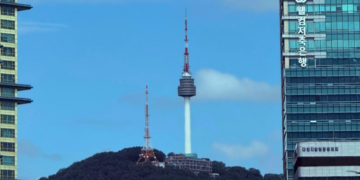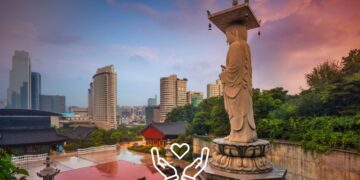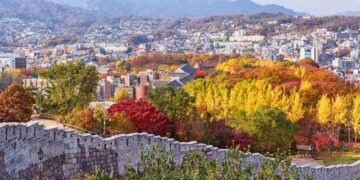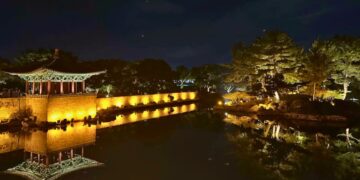Experience the charm of old Seoul at Eunpyeong Hanok Village. A must-visit destination for those interested in Korean history and culture.
While most tourists are familiar with Bukchon Hanok Village in Seoul, Eunpyeong Hanok Village is a hidden gem that most wouldn’t have heard about. Considering the restrictions on number of tourists visiting the Bukchon residential area, it is high time to explore other hanok villages in Seoul.
Eunpyeong village is the ideal spot for a peaceful day trip from the city’s chaos. It’s much less crowded than Bukchon Hanok Village, so you’ll have plenty of time to explore this charming area just outside Seoul.
Plan a trip to Eunpyeog Hanok Village
Eunpyeong Hanok Village (은평한옥마을)
Located at the base of Bukhansan Mountain range, Eunpyeong Hanok Village comes in the Eunpyeong district of Seoul. This traditional Korean village was established in December 2014. There used to be few original hanoks standing in the area but it was developed to become the largest neo-hanok residential area. Just like every hanok village, Eunpyeong has a charming old-town vibe. The hanoks here are made with tiled roofs and wooden frames, and they’re all decked out with beautiful gardens and courtyards.
At the present time, there are more than 150 hanoks, traditional Korean houses, in the village. Some of the hanoks are also open for tourists to stay and experience hanok. You can participate in traditional craft activities in these residences to get the full experience.
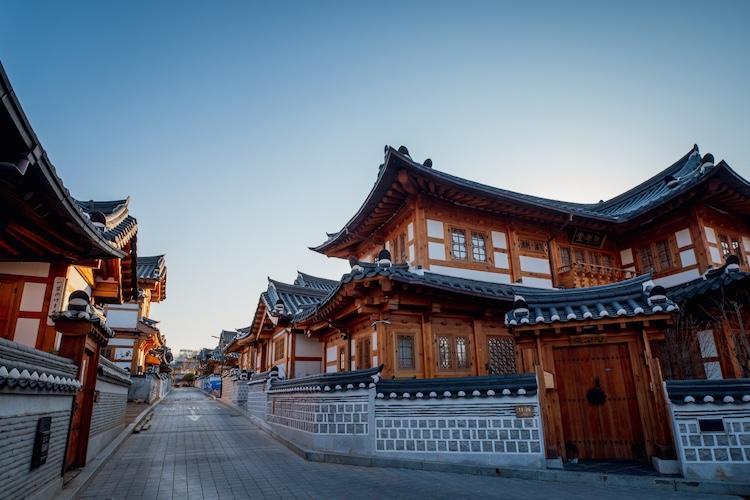
What makes Eunpyeong Hanok Village unique?
Seoul City planned and built this village as a cultural, historical, and tourist site, distinguishing it from Bukchon. It still holds all the authentic charm of a hanok village without being too touristy or kitschy. Just like in any other original hanok village, you can enjoy a peaceful time with quiet walks, calm cafes, temples, and walking pathways going up in the mountains.
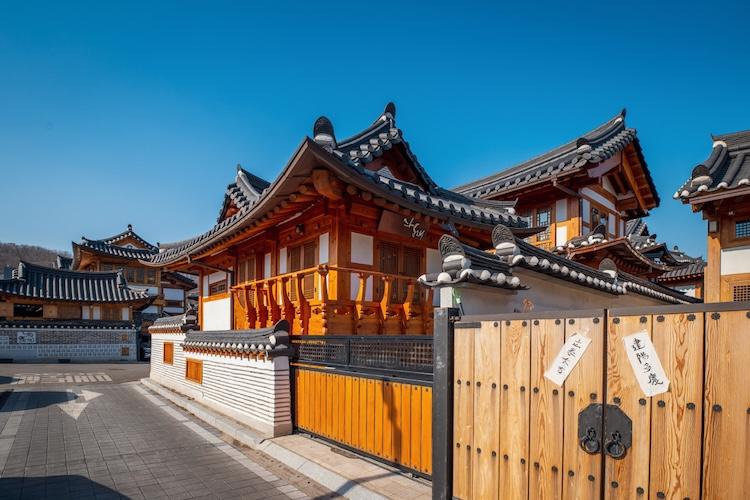
As it is a planned tourist site, you won’t find residents protesting against onslaught of tourists in their midst. The village is open to visitors and you can enjoy a self-guided tour of the village at your pace. Exploring the alleys, taking pictures, and learning about the rich Korean history – you can do everything here leisurely. And its less popularity among tourists ensures that you can spend as much time as you want without the over crowded feeling. If you feel peckish, there are plenty of delicious food options to choose from. Or, if you just want to relax, you can head to the popular cafe overlooking the village for a cozy treat.
Nestled in a prime location, this village offers easy access to forest paths like the Eunpyeong Dulle-gil Trail, one of Korea’s most famous mountains, Bukhansan Mountain. You’ll also find wooden boardwalk courses for both locals and tourists. Along the way, you’ll find signs that tell you about the village’s history and current status.
How to get there from Seoul?
If you are in Myeongdong area in Seoul, the easiest way to get to the village is by taking Line 3 (towards Gupabal station Exit 3) followed by Bus 7211/7723. The trip takes about 40 minutes and you reach right to the village entrance. If you are at Seoul station, you can take the Bus 701 directly.
Planning to drive down directly, it’s best to use Naver map and get live directions. Type in this – 서울특별시 은평구 진관동 193-14. In case you are a Google Maps user, put in this address – 서울특별시 은평구 진관동 127-25.
Eunpyeong Hanok Village opening hours: Eunpyeong Hanok Village is open 24 hours a day, and you don’t need to pay any admission fees.
What to do at Eunpyeong Hanok Village?
Eunpyeong History Hanok Museum (은평 역사한옥 박물관)
Step back in time to the 17th century and immerse yourself in the rich history of Eunpyeong at the Hanok Museum. This traditional Korean house is a living museum, offering a glimpse into the arts, culture, and daily life of people residing in original homes. The museum also has proper Korean traditional home-like setup including kitchen, living room, and bedrooms. You’ll find a collection of artifacts and furnishings that capture the essence of this era. And if you want to learn ore about Korean culture, there are a variety of educational activities, including tea ceremonies and crafts workshops by the museum.
Cafe 1인1상
1인1상 is a must-visit cafe in Eunpyeong hanok village! It has 5 floors and the highest floor offers some of the best views of the village with the backdrop of mountains. It’s best to wait a bit until the rooftop is open as you will get a much nicer view than sitting on the ground floor level. The highest floor also gets crowded so you will have to arrive early enough, around 11 am, to secure your spot.
If the weather isn’t favorable to sit out on the rooftop, you can take upper floors and take in the views from the large windows.
Jingwansa Temple (진관사 (서울))
Jingwansa Temple is a stunning Buddhist temple nestled in the beautiful mountains of South Korea. Built way back in the 8th century, this historic temple is a perfect example of traditional Korean architecture. The temple you can now see is more modern after many rebuilding and restoration efforts. You can wander through its many courtyards and halls, each one filled with amazing artwork and symbols that tell the story of Korean Buddhism. It is an important religious site for Buddhists in South Korea. It’s a peaceful place where you can connect with nature and enjoy the breathtaking views.
Jingwansa Temple’s main hall is a treasure trove of Buddha statues, including the Medicine Buddha and the Cosmic Buddhas of the Four Directions. You’ll also find Seokgamoni-bul, or “The Historical Buddha,” which shows the real person who brought Buddhism to Korea. And Jijangjeon Hall has statues of 10 kings who protect Buddhism.
Jingwansa Temple is not just about culture; it also has lots of fun outdoor activities. You can take a short hike up Gwanaksan Mountain for amazing views of the area. Or, if you’re feeling adventurous, you can go on a longer hike through the beautiful hillsides. For an even more relaxed outlook, you can check out the nearby rock garden. It’s the right place to admire the natural scenery while exploring old relics. Jingwansa Temple is a must-visit for anyone who wants adventure and peace!
Tombstone for Lady Sukyeong (숙용심씨 묘표)
This is the Seoul Monument No. 25 from early 16th century. The tombstone
This tombstone was erected in front of the tomb of Lady Sukyong (?~1515), King Seongjong’s concubine. Lady Sukyong, the daughter of Sim Maldong, who contributed to the enthronement of King Sejo. She was consequently bestowed the title of a meritorious retainer.
She became King Seongjong’s concubine before 1493 (24th year of King Seongjong’s reign) and gave birth to 2 sons (Princes Iseong and Yeongsan) and 2 daughters (Princesses Gyeongsun and Sukhye). It is recorded that Lady Sukyong died in 1515 (10th year of King Jungjong’s reign). The tombstone consists of the top portion, the stele body, and the base.
This tombstone was moved to Japan and was placed in a park commemorating Takahashi Korekiyo, Prime Minister of Japan, who was assassinated in 1936. It was thanks to the efforts of her descendants that the tombstone was brought back to Korea in 2001. It was located in Japan for more than four hundred years before it finally returned home. This tombstone carries a great significance as a royal heritage in that it proves the existence of the tomb of King Seongjong’s concubine, Lady Sukyong.
Galleries and art museums in Eunpyeong hanok village
You can explore art galleries and museums in the village if you are into the art scene.
- Set Iseo Literary Museum (셋이서문학관)
- Samgaksan Geumam art museum (삼각산금암미술관)
- Gallery Io (갤러리 이오)
Snow covered village
The winter months add another level of beauty to the village in Seoul.
Other Hanok Villages to see in Korea
In case you don’t manage to see Eunpyeong hanok village and you’re more interested in a guided tour to spend some time in one, then make sure you see some of the options below:
Related Posts
3,553 total views, 3 views today


